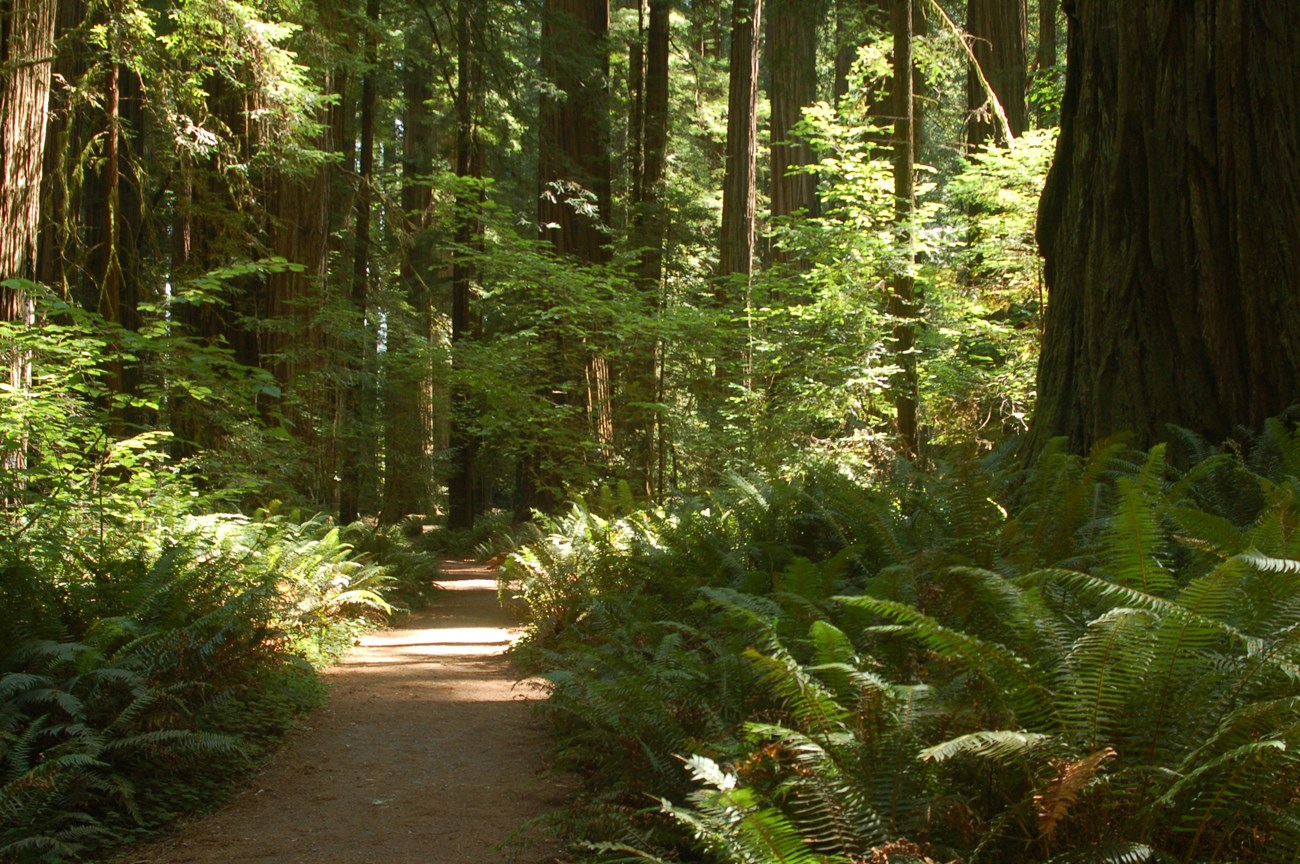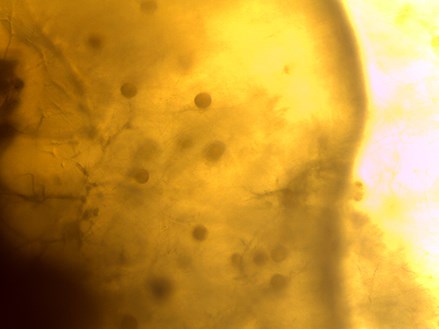Last updated: October 21, 2020
Article
Checking the Vitals of Diseased Trees in Redwood National Park

Phytophthora ramorum is a type of water mold – a microorganism whose reproductive spores scatter when raindrops splash on leaves. Water molds cause many plant diseases, including some that profoundly affect human societies. It was a species of Phytophthora (the name is Greek for “plant destroyer”) that caused the famous potato blight in Ireland in the 19th century.

Lucy Kerhoulas
Scientists have studied Sudden Oak Death for years. They’ve paid less attention to Ramorum Leaf Blight and its consequences for the health of trees in a forest. That made a plant scientist and her undergraduate students wonder about the non-lethal effects of the water mold. They decided to investigate how the leaf blight affects the physiology of understory trees in Redwood National Park.
Dr. Lucy Kerhoulas is a forest physiologist at Humboldt State University. Jes Suoja and William Weinberg just completed their bachelor’s degrees in forestry, and spent the summer of 2019 doing research with Lucy. They both intend to continue their scientific training in graduate school.

Photo by Nick Kerhoulas
Paint a picture of the forest and the key species related to your research
Jes: We're in this forest of these famous, tall redwood trees that get the most attention. But we focus mainly on understory hardwood trees, tanoak and California bay, that are really important in that ecosystem. There are a lot of wildlife species that rely on them, like the Humboldt’s flying squirrel, which uses them for nesting habitat and food. And tanoak is really important for several Native American tribes, for both food and rituals.

Lucy: Phytophthora ramorum infects many trees in the redwood forest ecosystem. In Tall Trees Grove tanoak and bay were copiously infected. They were an easy couple of species to grab and investigate, and with a lot of ecological importance.
William: It was in the 1990s they found P. ramorum in Rhododendron shrubs imported by nurseries and used for landscaping. Soon after that it was seen in the wild. So far, it’s spread all the way down to Monterey County and up to southwestern Oregon.
How did your project begin?
Lucy: Sudden Oak Death is well studied because that gets people's attention. But the leaf blight that doesn't kill trees – nobody seemed to be investigating if there are adverse effects. I was sort of curious about that. Some colleagues had a grant to study the genetics of Phytophthora, and they wanted to add an ecological component. So I wrote up a little complement to their genetic study. I'd already worked in Redwood National Park on other research projects, and I knew a lot of the people up there. It seemed like a friendly place to do work.
You measured some aspects of tree physiology – water potential, net photosynthetic rate, stomatal conductance, and water use efficiency. What are those?
Lucy: Water potential is a measure of how hydrated the plant is – how much tension is placed on the water inside the plant. Jes and William measured it in the forest with fresh-cut branches and a device called a pressure bomb. They measured the other variables in the lab. You place a leaf into a sealed chamber with sensors that measure how quickly it takes up carbon dioxide. That's the net photosynthetic rate. Other sensors measure how quickly it loses water through microscopic pores called stomata. That rate is the stomatal conductance. And the ratio of those two is water use efficiency – how much carbon dioxide is gained per amount of water lost over a given period of time.
Why are they important?
William: They’re good signs of the vitality of a plant. How well can it take in carbon dioxide to make the sugars it needs? How well can it move water out of its leaves and get the water moving through the rest of the tree? If it’s not able to move the water, it would be like we're not able to pump our blood.

William: We compared infected branches and healthy branches from the same tree. That let us understand how the pathogen affected physiology while controlling for any other differences between trees. We sampled 10 trees of each species. And we took three cuttings for each type of branch. So that ended up being 30 healthy branches and 30 infected branches for each species of tree.
And what did you find?
William: Our study is still going through scientific peer review, so I can’t describe detailed results. In general, physiological capacity was lower in infected samples, especially with regard to water potential and net photosynthesis. And tanoak tended to be more strongly affected than was California bay.
Are there implications for the whole forest landscape?
Lucy: Particularly given projections for climate change – becoming hotter and drier – it’s important to know if this pathogen in leaves causes increased water stress. That could make forests more vulnerable to drought. On the flip side, if the environment becomes dry enough, this aridity could limit the pathogen’s spread. And for folks modeling how much carbon is taken up and stored by forests, I think it's important to know if this leaf pathogen – which can occur on well over 100 tree species – can have significant effects on carbon uptake rates.
Jes: These results on tree sensitivity can be combined with geographic data. If we can have a good idea of where the pathogen is, coupled with where these really sensitive host trees are, as well as wildlife species ranges, I think it would be possible for us to model the broader implications for these forests.
Tell me a little bit about your lives as field researchers.
William: We both had jobs during the week so we ended up doing this only on weekends. I had a bum knee and Jes had a bum ankle, so we had to hike through the woods very slowly. But we were right next to Redwood Creek. We ate lunch there every weekend, which was beautiful.
Jes: That is not an easy hike to do, especially in the summer when you're hiking up and out at three o'clock, when it's super hot, carrying nitrogen tanks and whatnot.
Lucy: William and Jes were carrying really heavy equipment like the pressure bomb they use for measuring water potential. I feel like when people see you using it, you look like mad scientists. You have safety goggles on and there's pressurized gas, and heavy metal objects.
Jes: There were definitely a lot of people on the trail who asked us what we were doing. Some had heard of Sudden Oak Death. It was nice because most of the people who did ask were really interested in learning.
Jes and William, you're brand new to research. What's it like getting involved for the first time?
Jes: It's definitely exciting and scary. There are a lot of questions that need to be answered, but you have to decide which one you want to answer because you can’t answer all of them. And I don't really know what answers I'm gonna get. I'm definitely excited to be in this field, because I think that it's going to become increasingly important.

Christopher Lee
What do you want young adults to know and value about science?
Lucy: Two things come to mind. One is, it's a way of thinking and of looking at the world. Right now, it's really important for people to think critically. The other is that studying the natural world is a really nice use of your time on the planet. I find it like a tonic, personally, to not get lost in all of the craziness of humanity and just kind of study the natural world. I think that can lead to really healthy, happy lifestyles.
Jes: There's always going to be more to learn. That really sparks a lot of interest in me, and always has. I would like to see more people my age and younger going into science, and focusing their efforts on trying to learn as much as they can about the natural world, especially as climate change starts to change that world even more.
William: Science informs so many different aspects of what goes on in our society. It's so important that we use what we know and what we learn to protect and manage these forests. And that is really what drove me to be a scientist and how I want others to see science. It's a tool to help us work on everything else.
Any summary thoughts, looking back?
Jes: I'll be honest, I had absolutely no idea what I was getting myself into but I don't regret any of it. This pathogen came over because of nurseries so I feel a moral obligation to find out about it and try to save a species that could be wiped out in my lifetime. When I think of California, I think of the oak woodlands. It is kind of an important topic for me.
William: It was good for me to do this research because it helped broaden my skills. And I learned so much about something that I didn't really care about before. I have more respect for tanoak now than I used to. I guess it's emotional, but I was more motivated by a thirst for knowledge.
Tim Watkins is the Science Access and Engagement Coordinator for the National Park Service, based in Washington, DC. He taught college biology and did field and laboratory research on tadpoles for many years, and has a passion for helping people see science as an accessible human endeavor full of interesting stories.
